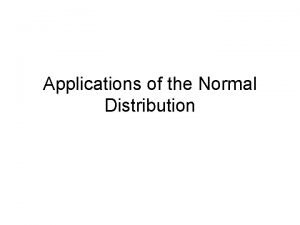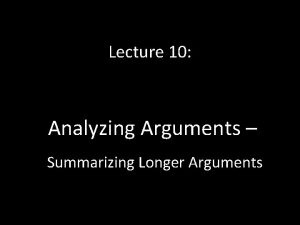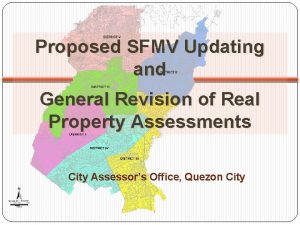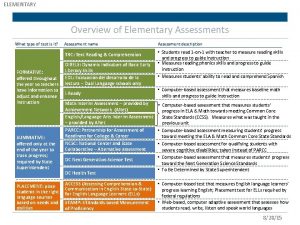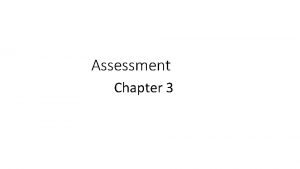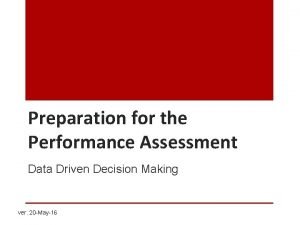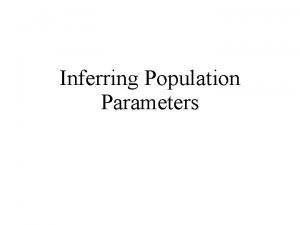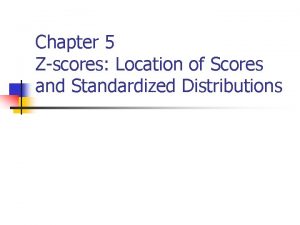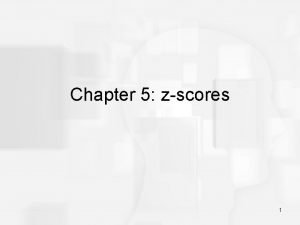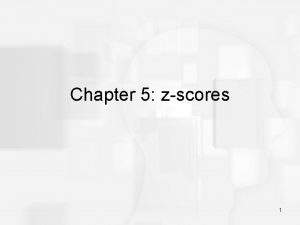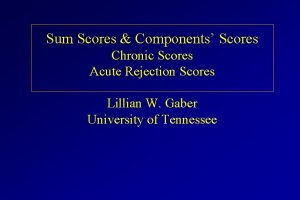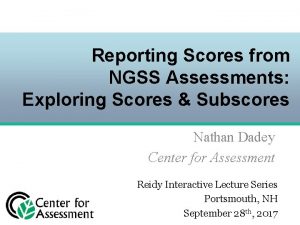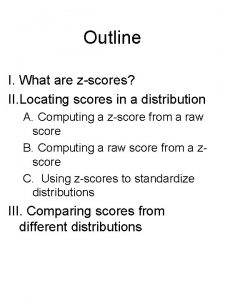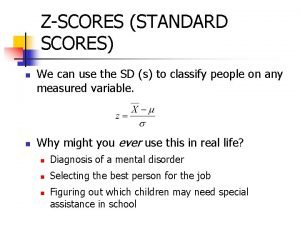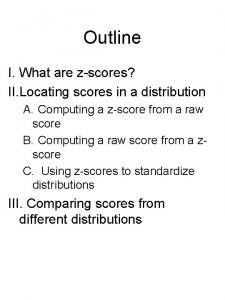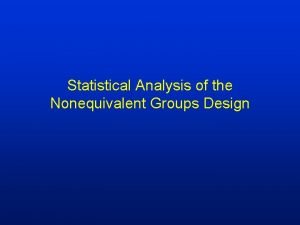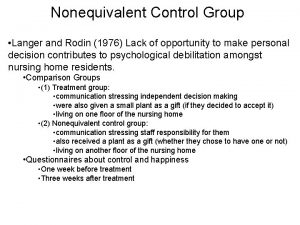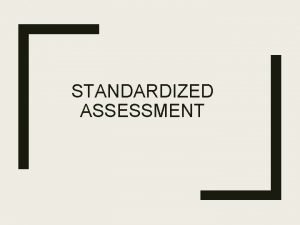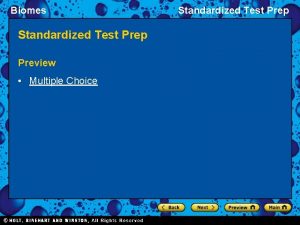zScores Standardized Scores Standardizing scores With nonequivalent assessments

































- Slides: 33

z-Scores Standardized Scores

Standardizing scores • With non-equivalent assessments it is not possible to develop additive summary statistics. – e. g. , averaging the scores from assessments with different maximum scores. • In classrooms we solve this problem by assigning grades which represent a uniform evaluation for every assessment. – i. e. , A, B, C, D, F

Standardizing scores • Grades often have a subjective interpretation which makes comparing students using average grades problematic. • Assuming that assessments themselves are minimally subjective (i. e. , well-designed) some consistent measure of student achievement can be used across assessments.

Histogram • A bar chart of a frequency distribution. 0 — 2 1 — 3 2 — 0 3 — 2 4 — 4 5 — 3 6 — 3 7 — 5 8 — 3 9 — 2 10— 2

Summary Statistics • The summary statistics used to describe interval data are mean and standard deviation. • Standard deviation represents the average distance of observed scores from the mean. • Any given score can be represented as the number of standard deviations from the mean.

z-Scores • Hence: A z-score is the distance a given score is from the mean divided by the standard deviation. (score – mean)/standard deviation = z • A z-score is a given score translated into units of standard deviation. Common standard score for any interval assessment

z-Score Computation • Subtract the mean of the distribution from the target score. • Divide by the standard deviation. • Positive z-scores are above the mean. • Negative z-scores are below the mean.

Histogram • A bar chart of a frequency distribution. 0 — 2 1 — 3 2 — 0 3 — 2 4 — 4 5 — 3 6 — 3 7 — 5 8 — 3 9 — 2 10— 2 Mean = 5. 74 sd = 2. 61

z-Score Computation • For a score of 9: z = (9 -5. 74)/2. 61 = 1. 25 sd above the mean • For a score of 4: z = (4 -5. 74)/2. 61 = - 0. 67 sd below the mean • Positive z-scores are above the mean. • Negative z-scores are below the mean.

What is Molly’s z-score on the test? What is Karl’s • • 34 56 22 31 44 47 37 Karl • • 42 51 37 40 29 36 39 • • 52 39 29 51 45 47 42 Molly

z-Scores A special case with Normal Distributions

Normal distribution Gaussian distribution Continuous probability distribution Normal curve Characteristic curve Bell curve This is a simplified histogram–a line connecting the tops of the bars of a histogram.

Normal Distributions • Artificial construction—do not occur in nature • A lot of things seem like they are normally distributed but they are only close • Standardized tests are constructed to be normally distributed

Properties of Normal Distributions In a normal distribution the mean, median and mode appear at the same point. Normal distributions are symmetrical.

Normal Curves Mean 1 Standard Deviation

Normal Curves 1 Standard Deviation Mean 50. 0

Normal Curves 1 Standard Deviation Mean 50. 0 34. 13

Normal Curves 2 Standard Deviations Mean 50. 0 34. 13 13. 59

Normal Curves 0. 13% 2. 14% 13. 59% Standard Deviations -3 -2 -1 34. 13% 0 13. 59% 2. 14% +1 The Empirical Rule +2 +3

Cognitive abilities are generally normally distributed. Then, if the tests are designed carefully the assessment of cognitive ability should be normally distributed as well. Results from a standardized test are, by definition, normal distributed. A test score

z Scores Mean -3 -2 -1 1 2 3 SD A test score If you know the percentage of scores that are lower than the target score you will know the Percentile Rank of the target score.

Normal Curves 2 Standard Deviations Mean 50. 0 34. 13 13. 59 1. The relationship between SD and percentage of the area under the curve is constant regardless of the distribution. 2. If the mean and SD of the distribution are known the percentage of scores lower than every possible score can be computed. 3. In other words, percentile rank of every score can be computed.

Subtract the mean of the distribution from the target score. Divide by the standard deviation. Look up the z score on the z table. Target Score (28) Mean (25. 69) 1 SD (2. 72) -3 -2 -1 Percentage of scores lower than the target score 1 2 3 SD Number of SD away from the mean

z Score • • • Target score (28) Score - Mean (28 - 25. 69 = 2. 31) Result / SD (2. 31 / 2. 72 =. 85) Look up on z table (0. 85) z = 0. 85; area =. 8023 Score is in the 80 th percentile

z Scores 28 25. 69 -3 -2 -1 1. 85 SD 80 % of scores 2 3 SD

z Scores Target Score Mean -3 -2 -1 1 2 3 SD

z Scores 23 25. 69 -3 -2 -1 -. 99 SD 16 % of scores 1 2 3 SD

z Score • • • Target score (23) Score - Mean (23 - 25. 69 = -2. 69) Result / SD (-2. 69 / 2. 72 = -. 99) Look up on z table (-. 99) z = -0. 99; area =. 1611 Score is in the 16 th percentile

z Scores 23 25. 69 -3 -2 -1 -. 99 SD 16 % of scores 1 2 3 SD

Percentile Rankings • z Scores • Assume a normal distribution • Based on knowing everyone in the population • Allows comparison of individual to the whole

Practice • Open the Excel file from the course webpage: OWM Data • What is the percentile rank of a score of 10 on the variable pre? • What is the percentile rank of a score of 10 on the variable delayed?

Normal Curves 0. 13% 2. 14% 13. 59% Standard Deviations (z-scores) -3 Cumulative Percentages -2 0. 01% Percentile Equivalents -1 2. 3% 1 34. 13% 5 15. 9% 10 20 34. 13% 0 50. 0% 0. 13% 13. 59% 2. 14% +1 +2 84. 1% 97. 7% 40 60 80 30 50 70 +3 99. 9% 90 95 99 Standford-Benet IQ Scores 55 70 85 100 115 130 145 SAT Scores (sd 209) 400 608 817 1026 1235 1444 1600

Bobby and Sally take a standardized test that has 160 questions • Bobby gets a raw score of 140 and has a percentile rank of 52. Sally gets a raw score of 142 and has a percentile rank of 67. • This doesn’t make sense to Bobby’s mother. First, how can 140 out of 160 be 52 nd percentile. And second, why should just a couple of points on the test make such a huge percentile rank difference? What are you going to tell her? • Explain this to Bobby’s mother in a paragraph or two and send me what you have written. • For a challenge (if you have time), what is the mean and standard deviation for this test? (solution)
 Nonequivalent control group design
Nonequivalent control group design Zscorelive
Zscorelive What is a standard recipe
What is a standard recipe Standardizing normal distribution
Standardizing normal distribution Standardizing arguments critical thinking
Standardizing arguments critical thinking Typologies are nominal composite measures
Typologies are nominal composite measures Informal assessments for transition planning
Informal assessments for transition planning Common core ela assessments
Common core ela assessments Rhode island comprehensive assessments system
Rhode island comprehensive assessments system Next generation assessments
Next generation assessments Florida assessments for instruction in reading
Florida assessments for instruction in reading Irip
Irip Fs assessments.org/apm
Fs assessments.org/apm General revision of assessments and property classification
General revision of assessments and property classification Creative arts grade 7 assessments
Creative arts grade 7 assessments Anet interim assessments
Anet interim assessments Iowa staewide assessment of student progress
Iowa staewide assessment of student progress Slidetodoc.com
Slidetodoc.com Formative summative diagnostic
Formative summative diagnostic Informative assesment
Informative assesment Characteristics of psychological test
Characteristics of psychological test Forsonline
Forsonline Occupational therapy assessments for low vision
Occupational therapy assessments for low vision Pba meaning school
Pba meaning school Kentucky assessments science
Kentucky assessments science Ddi assessments
Ddi assessments Disadvantages of formal assessment
Disadvantages of formal assessment Sat subscores
Sat subscores Performance assessments examples
Performance assessments examples Common core formative assessments
Common core formative assessments Rhode island comprehensive assessments system
Rhode island comprehensive assessments system Sample glba risk assessments for banks
Sample glba risk assessments for banks Incas assessment
Incas assessment Mlpp assessments
Mlpp assessments



